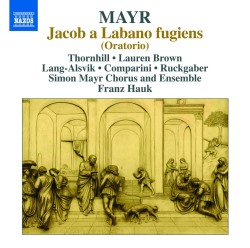
|
Simon MAYR (1763 – 1845)
Jacob a Labano fugiens (Jacob’s Flight from Laban), Oratorio for soloists, choir and orchestra (1791)
Siri Karoline Thornhill (soprano) – Laban; Andrea Lauren Brown (soprano) – Leah; Gunhild Lang-Alsvik (soprano) – Rachel; Julie Comparini (mezzo-soprano) – Jacob; Katharina Ruckgaber (soprano) – Shepherd
Simon Mayr Chorus and Ensemble/Franz Hauk
rec. Kongregationssaal, Neuburg an der Donau, Germany, 2011
Latin libretto with English and German translations available online.
NAXOS 8.573237 [78:47]
Naxos continue their admirable Mayr series with yet another world premiere recording.
Mayr was born in Bavaria, near Ingolstadt but came early to Italy where he studied at Bergamo with Carlo Lenzi. During a long life he was a prolific composer of operas (nearly seventy) and some six hundred sacred works. Jacob a Labano fugiens must be one of his earliest compositions and in any case his first oratorio. Maybe some of his later works in the genre are more personal, but for a maiden work this is a thoroughly professional creation and his inventive scoring, so characteristic of the works I have heard hitherto, is already well developed. Just listen to the fresh and captivating sinfonia. Where I feel some hesitation is in the allocation of voices among the five characters. Four sopranos and one mezzo-soprano offer little variation in vocal colour, and good though the singers are, i would have appreciated some deeper colours but that’s the way it is.
As for the music it is very agreeable and several arias are top-drawer Mayr. Leah’s aria Ah prata adite (tr. 4) is a gem and it is excellently sung by Andrea Lauren Brown; Laban has two dramatic arias, one in each part (tr. 6; tr. 24), and the Norwegian Siri Karoline Thornhill is brilliant; Jacob is sung by the only mezzo, Julie Comparini, and in both arias (tr. 15; tr. 27) he/she is accompanied by an obbligato oboe. The second of the arias, Date mihi extremum vale, is one of the best things in the work.
Rachel, sung by another Norwegian, Gunhild Lang-Alsvik, in the recitative and aria Imaginem delebo … Per loca incerta obscura (tr. 11-12) sounds distant or weak to begin with. Maybe the tessitura is too low for her. Towards the end of the aria she shows her true mettle with some brilliant high notes. Her second aria, Pater amans, pater chare (tr. 22), fares better and here she is in nice company with an obbligato bassoon. There is also a beautiful aria for the shepherd, Gemendo suspiro (tr. 19), and Katharina Ruckgaber is very good here – another gem.
There are recitatives, most of them not too extended, and several terzettos with chorus. It can be noted that the chorus part of the work is rather modest, but what they have to sing they sing well.
Those who have been following this series can safely invest in this latest instalment, and to those who haven’t I can say: It’s never too late to start.
Göran Forsling
 |
 |
|
